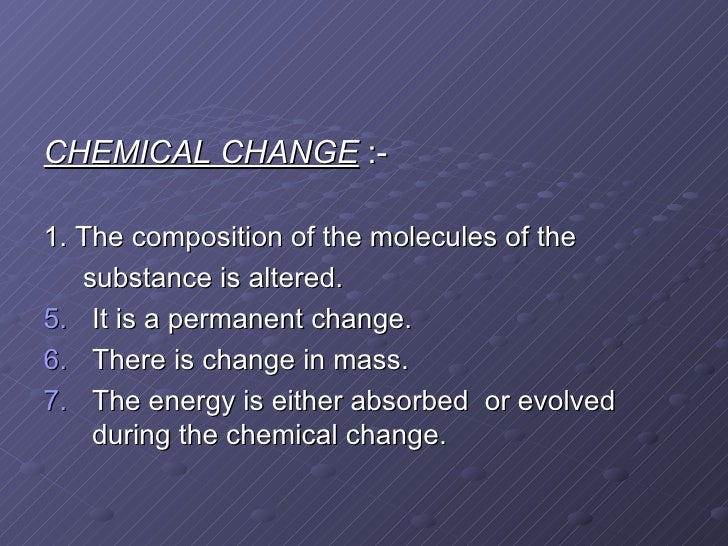
(iii) a large amount of heat and light energy are evolved.įix a candle on the table and light it.
/TC_608336-examples-of-physical-changes-5aa986371f4e1300371ebebb.png)
(ii) a new product is formed which has entirely different properties and (i) the change brought about in magnesium is permanent in nature The magnesium oxide, so formed, does not change to magnesium ribbon on cooling. It leaves behind a white ash, which is commonly called magnesium oxide. The magnesium ribbon burns with a brilliant white flame producing a large amount of heat and light. Heat magnesium ribbon in the non-luminous flame for about 2 minutes. Hold a short length (about 50 cm) of magnesium ribbon in the fire tongs. Let’s see few experiments showing chemical changes. Such changes are called chemical changes. The changes are permanent in nature and cannot be reversed. Thus, the changing of iron wire into a magnet is a temporary change and no new products are formed Thus, we can conclude that wire has lost its magnetic property. It is observed that iron filings no longer stick to the iron wire. Now hit the wire against the table for 50 times. Thus, we can conclude that wire has changed into a magnet. What do you observe? Iron filings stick to the wire. Take a bicycle spoke (wire fitted in wheel of bicycle) and rub it with a permanent bar magnet. Thus, the change in the appearance of the bulb is temporary in nature. When current is switched off, the filament does not give off any light. Similarly, when electric current flows through a bulb, its filament gets white hot and emits light. Thus, we can say that the change brought about in the appearance of the wire is temporary in nature. What do you observe? The wire regains its original colour. Take out the end of wire from the Bunsen flame and allow it to cool. Hold the end of wire in a non-luminous Bunsen flame. Hold a short length of platinum wire or nichrome wire with the help of tongs. (iii) there is no change in weight when change takes place. Thus, we can say that the above changes are Furthermore, the mass of common salt remains same. It is observed that water disappears leaving behind common salt. Now evaporate the salt solution on heated sand bath. Add a spoonful of common salt in it and stir. However, on cooling, its colour changes back to yellow. Similarly, if we heat lead monoxide powder, which is yellow in colour, its colour changes to reddish brown. Thus, we can say that the change in zinc oxide was temporary in nature. In a few minutes, the colour of zinc oxide changes to white colour. What do you notice after 2 minutes of heating? Place about 2 g of zinc oxide in a dry test tube. Similarly, ice, ghee, butter, etc., melt on heating and solidify on cooling. Thus, we can say that on heating wax melts and on cooling, the liquid wax solidifies, but no new products are formed. Now cool the tube by holding it in cold water. The wax melts to form a colourless liquid.

Meat the test tube gently on a Bunsen flame. Take a dry hard glass test tube and put in it about 2 g of candle wax. Let’s see few experiments showing physical changes. Such changes are called physical changes. The changes are temporary in nature and can be reversed. Chemical changes are generally permanent in nature and new substances are formed, which have entirely new properties. Physical changes are generally temporary in nature and no new substances are formed. Most of these changes can be classified under two headings: These changes generally get accelerated, if we heat the substances.

In other cases, the changes are obvious and easy to detect. In some cases, the changes are small and difficult to detect. The solid sugar never loses its properties, the molecules become separated by water and the sugar can easily be recovered by evaporating the water.All substances around us undergo changes. Hot molten iron is a liquid and when left to cool will from solid steel and can take many forms.ĥ.ĝissolving sugar in water is a physical change. It turns to a gas but maintains the properties of alcohol.Ĥ. Rubbing alcohol left uncovered will evaporate quickly into the air. Water boiling is a physical change as water molecules vibrate faster, they enter the gas phase and become water vapor.ģ. Ice melting involves a change from a solid to a liquid and the substances maintain the properties of water because the molecules never change.Ģ.


 0 kommentar(er)
0 kommentar(er)
